Steering Levers
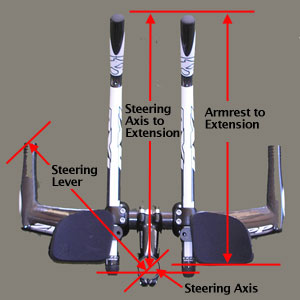
Almost all attention in bike fit is given to the fit coordinates while in the aero position. This, for good reason. This is almost exclusively where you're positioned during your riding or, if you aren't, you should be and we need to fix what's keeping you from being there.
But it's a mistake to give the pursuit position short shrift, because, when your hands are out there chances are something important is going on. Braking, descending, cornering, riding out of the saddle, and some combinations of these maneuvers are going on when your hands are on the pursuits. Consequently, if this position is not optimized, you're compromised when you're executing these maneuvers.
A Slowtwitcher caught me in a generalization last week, and called me on it on our reader forum. I wrote the statement that, in general, stems on tri bikes ought to be about 2cm or 2.5cm shorter than a stem on that rider's corresponding road race bike. The astute Slowtwitcher pointed out:
Handling is affected by the distance from the steering axis to the rider contact point. It does not matter if there is a long or a short stem in-between. [bigdog]
He is, of course, right. What I did was gloss over the occasions where longer stems do, or might, make sense. However, he caught me just prior to the publication of this, an article I've been planning on writing for some time and that is frankly long overdue.
This is one of two articles I'll write on the subject, and we're talking about steering levers, and you might subtitle this, "Pursuit Contact: The X-Axis." We're talking about the distance between the steering axis and the point where the turn is initiated, and where the weight is placed, while in the pursuit position.
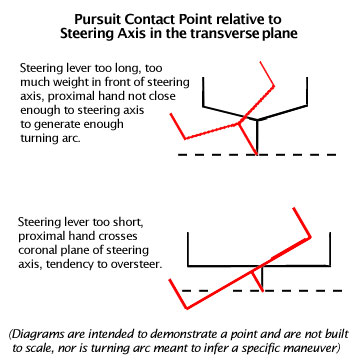
We might call the steering lever the distance from the steering axis to the centerline of the contact point (the hand-hold position); or we might measure it to the leading edge of the hand (the frontal protrusion of the index finger, where the brake lever plugs into the pursuit bar). I don't know that this metric has been so-described elsewhere, so, I'll just pick one—the latter.
What happens when the steering lever is too long, especially when the turn executed by the hands doesn't generate enough of an angular change in the front wheel's direction? It feels a little like the old '64 VW bus I used to drive in Mexico during college Summer vacations: lots of turning the steering wheel with little actual turning effect on the front wheels themselves.
The problems are these: The steering lever is so long, the hands need to move a long distance to execute any axial rotation, or turning radius; the long lever means an awful lot of the rider's weight is sitting on top of the rider's hands, causing the rider to need to move not only the bike when he's executing a turn, but all that body weight; if the hands are not far enough apart (anybody remember Scott's 100k bars?), there is little ability to steer the bike left or right and maintain control.
So, what is the proper length of a steering lever? Well, that depends on a few things. First, we aren't talking today about the distance the pursuit contact point drops from the transverse plane—aka the contact point Y-axis—aka the amount the hands drop below (if any) the place the stem contacts the fork steer column. And, it depends certainly on how far out to the side of the steering axis the contact points reside.
However, if you were to tie me down and many me choose, I guess I like a steering lever between 25cm and 28cm long.

The important thing is to recognize that today's components give you options, and you can't just slap an aerobar on a pursuit bar, attach a stem and call it good. Each of these components carries with it what I might call "spatial imperatives." If you stick one of two pursuit bars on a bike—consider the two adjacent—your hands are thrust either further in front of the steering axis, or not, based on your choice. So, if there's a specific steering lever distance you admire, you must select the pursuit bar in concert with a specific stem, mustn't you?
Then, based on that stem length, you're left with a decision to make on aerobars. The shorter the stem, the more the aerobar pads can sit out over the pursuit bar. The longer the stem, the more the pads must be set back behind the pursuit bar. This, because—considering the front of the bike only for a moment—there are two places your weight resides while on your tri bike: on the hands when in the pursuits; and on the armrests when in the aero position. This armrest placement versus the steering axis is also an important consideration. But, we're not going to tackle that metric at this time.
There are a couple of ways you can go, using (as an example for this demonstration) a Bontrager Race X Lite Clip-On. Note the image highest above. These Bontrager bars are mounted on a Zipp VukaBull pursuit bar. This base bar features no forward protrusion of the contact points. Consequently, mounting the armrest pads behind the Race X Lite's extension clamps makes sense, because the distance from the pads to the pursuit contact points is a necessary metric to consider. But, if you employ this set up, then, you can use a somewhat longer stem; you move the extensions back a bit.
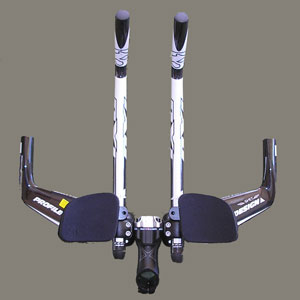
However, in the image adjacent, we're sticking a Profile Design Svet on the bike. The contact points are both a tad wider than on the VukaBull, and they're thrust out on front of the steering axis about 2cm. The entire distance of the steering lever, base bar to base bar, is about 2.5cm. Now, in this case, if the steering lever is something you'd like to keep constant, you have to put a shorter stem on the bike. And, frankly the Svet is really the more common style of base bar these days—both on the high and low ends of the price gradient—and this is mostly why I recommend the shorter stems on tri bikes these days.
However, if you admire the Race X Lite, well, let's talk about one way we might set this bar up differently when used on this base bar of a different geometry. Once we place the shorter stem on the bike, we have to move the armrests forward, if we're going to normalize for the proper distance from the steering axis to the armrests, and from the armrests to the pursuit contact points. So, we stick the armrest cradle in front of the extension clamp.
This works pretty well in theory, except doing this moves the armrests about 5cm, on center, in front of where they were before. We only need to normalize for 2cm of forward protrusion, one base bar to the other. So, if you move the armrests in front of the extension clamp, you have to unbolt the armrests from their cradles and move them back (which, by the way, I did not do when shooting the image adjacent).
In all honesty, we're all (in the fitting business and in bike manufacture) breaking new ground here. I don't know anyone who's really got all of this quantified in a system and fashion on which we can all agree and to which we can all stipulate. What I have found in general is that steering levers tend to be too long, sometimes combined with pursuit contact points too low to the ground. This seems to me to be a bigger problem than steering levers to short.
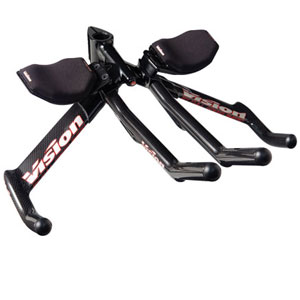
A case in point is Visiontech's old integrated aerobar adjacent. I am a big fan of Vision's aerobars, and only point out that this rather ancient design is the one product this fine company makes that I'm not a fan of. The steering lever is so long, and the drop so severe, as to make the out-of-the-saddle riding quite difficult to execute, and the braking and cornering laborious. While it was a favorite for a lot of pro bike racers who used it back in the day, it is less well adapted for triathletes.
In the future, I'll guess that these metrics pertaining to each plane will become the subject of fixed and known ranges. For example, maybe the distance from the steering axis to the end of the pursuit bar, where the brake lever plugs in, fore/aft, should be no less than 18cm and no more than 24cm, depending on the size of the rider. Is this an appropriate rule? I don't know, but, it's probably not too far off.
However, maybe such a distance depends on the elevation of the pursuit contact point relative to the saddle. I don't know.
The position of the armrest relative to the saddle, and the extension ends from both the saddle and the armrests, and the height of the armrests from the saddle as a function of seat angle and saddle height, are relatively well established. Pursuit contact points relative to these other fixed positions on the bike is probably the next area requiring investigation.


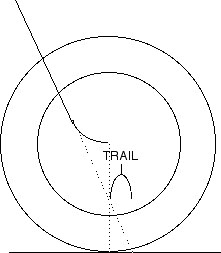
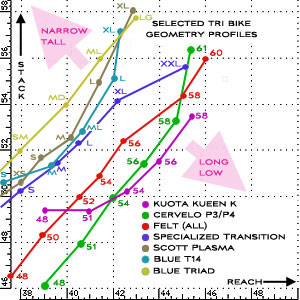
Start the discussion at slowtwitch.northend.network